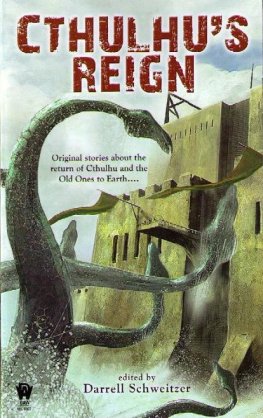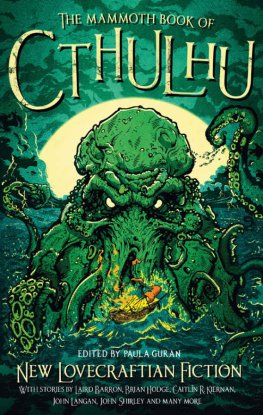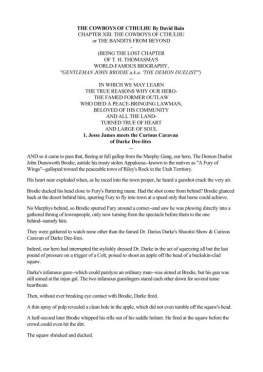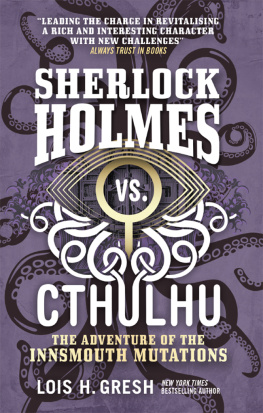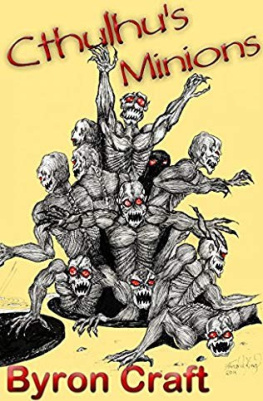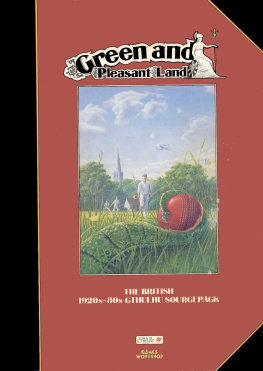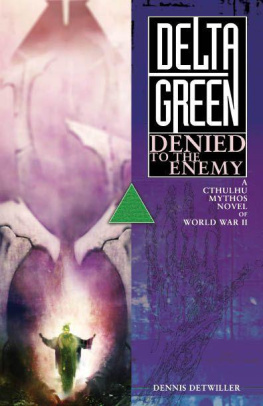Darrell Schweitzer
Cthulhu's Reign
Introduction copyright 2010 by Darrell Schweitzer
The Walker in the Cemetery, copyright 2010 by Ian Watson
Sanctuary, copyright 2010 by Don Webb
Her Acres of Pastoral Playground, copyright 2010 by Mike Allen
Spherical Trigonometry, copyright 2010 by Ken Asamatsu. English translation 2010 Edward Lipsett.
What Brings the Void, copyright 2010 by Will Murray
The New Pauline Corpus, copyright 2010 by Matt Cardin
Ghost Dancing, copyright 2010 by Darrell Schweitzer
This is How the World Ends, copyright 2010 by John R. Fultz
The Shallows, copyright 2010 by John Langan
Such Bright and Risen Madness in Our Names, copyright 2010 by Joseph E. Lake, Jr.
The Seals of New Rlyeh, copyright 2010 by Gregory Frost
The Holocaust of Ecstasy, copyright 2010 by Brian Stableford
Vastation, copyright 2010 by Laird Barron
Nothing Personal, copyright 2010 by Richard A. Lupoff
Remnants, copyright 2010 by Fred Chappell
WHEN ALL THE STARS ARE RIGHT ON THE EARTHS LAST NIGHT
An introduction by Darrell Schweitzer
All my tales, H. P. Lovecraft famously wrote, are based on the fundamental premise that human laws and interests and emotions have no validity or significance in the vast cosmos-at-large. To me there is nothing but puerility in a tale in which the human form and the local human passions and conditions and standards are depicted as native to other worlds or other universes. To achieve the essence of real externality, whether of time or space or dimension, one must forget that such things as organic life, good and evil, love and hate, and all such local attributes of a negligible and temporary race called mankind, have any existence at all.
That, we must admit, is a pretty stringent ideal, which even Lovecraft could not stick to all the time, it being inherent in the nature of fiction that a certain amount of human interest is necessary to keep human readers interested. Nevertheless he clearly stated the underlying philosophy behind his literary corpus, and had done so at a significant moment, because that letter accompanied the submission of the classic The Call of Cthulhu to Weird Tales in 1927.
It is probably unnecessary in this age of Google and Wikipedia to go into great detail about who H. P. Lovecraft was. Suffice it to say that Lovecraft (18901937) was the greatest writer of weird and horrific fiction in English in the 20th century. He published most of his work in pulp magazines, particularly in Weird Tales, and saw only one very limited, shabby book publication (of the novella The Shadow Over Innsmouth) in his lifetime. Were he not a strict mechanistic materialist who did not believe in such things as spirit or an afterlife, he might be looking down in utter astonishment to see his work not only published all over the world but reprinted under such prestigious imprints as Penguin Classics or Library of America, this latter explicitly placing him on the same level as his own literary idols, Edgar Allan Poe and Nathaniel Hawthorne.
One can only guess what he would have made of those plush Cthulhu dolls you can get from The Toy Vault, which are actually manufactured in China, and if anyone had told him, back in the 30s, that he would become a world-wide cultural phenomenon adapted into everything from films to comic books (just being invented in his time) and manga (unknown) to role-playing games (likewise), he would have thought his informant stark, raving mad.
A good deal of the reason for Lovecrafts enduring fame is his invention of the body of lore we call the Cthulhu Mythos although he did not use that term. The core of it is to be found in three key stories, The Call of Cthulhu, The Dunwich Horror, and The Shadow over Innsmouth, all written in the space of five years, between 1926 and 1931. Certainly other Lovecraft tales contain elements and allusions for example, Abdul Alhazred is mentioned for the first time in The Nameless City (1921) and the dread Necronomicon is introduced in The Hound (1922) but if you read just these three stories you will get the basics.
Not only is humanity negligible in the cosmos at large, says Lovecraft, but humans are only one of the many masters of the Earth, neither the first nor the last. In The Shadow out of Time (1935), a contemporary mans brain is exchanged through time with that of a member of the Great Race, cone-shaped beings from a civilization (ultimately of extraterrestrial origin) that flourished in Australia about 150 million years ago. From other kidnapped minds, the hero gains a hint of the earths post- human future, when, thousands of years hence, there will arise a civilization of intelligent beetles.
The Call of Cthulhu deals with the still lingering god, Cthulhu, who sleeps in the sunken island of Rlyeh below the South Pacific, and who once possessed the Earth and may one day awaken to reclaim it. But even Cthulhu may only dimly spy even vaster powers, the Old Ones of The Dunwich Horror, about whom we learn something in what is perhaps the most famous of all Necronomicon quotes:
Nor is it to be thought that man is either the oldest or the last of earths masters, or that the common bulk of life and substance walks alone. The Old Ones were, the Old Ones are, and the Old Ones shall be. Not in the spaces we know, but between them. They walk serene and primal, undimensioned and to us unseen. Yog-Sothoth knows the gate. Yog-Sothoth is the key and the guardian of the gate. He knows where the Old Ones broke through of old, and where They shall break through again. Man rules where They ruled once; They shall rule soon rule where man rules now. After summer is winter, and after winter summer. They wait patient and potent, for here shall They reign again.
In The Call of Cthulhu, the sunken island of Rlyeh actually is heaved to the surface of the Pacific by an earthquake and the awful, squid-headed god walks (or shambles) beneath the clear sky for the first time in vigintillions of years, but conditions are not quite right and the island sinks again, and mankind has had a narrow escape more through sheer luck than anything anyone actually did about the matter. In The Dunwich Horror, a degenerate back-country sorcerer manages to impregnate his daughter with the seed of Yog-Sothoth, resulting in twins, one of which, Wilbur Whateley, superficially resembles a human being, whereas his brother (the horror of the title) decidedly does not. In The Shadow over Innsmouth, the tourist narrator discovers an entire town taken over by cultists of the Old Ones and especially of the sea-god Dagon. The Innsmouthites have a peculiar look which becomes more pronounced as they age, because they have been interbreeding with the Deep Ones, minions of Dagon, and eventually transform into an aquatic, post- human form in the course of their very long (possibly immortal) lives.
What we are intended to take away from these stories is the notion that humanitys existence is a transient and precarious affair, and that most of us are better off with the delusion (encouraged by most of the worlds conventional religions) that we are the center of the universe, watched over by benevolent angels and deities. The truth, says Lovecraft, is likely to drive you mad. While Lovecraft did not personally believe in any supernatural beings or forces and had invented the Necronomicon as a tongue-in-cheek hoax, he did, through the Cthulhu Mythos, express in an indirect yet dramatic way his most firmly held beliefs about the nature of our existence: that the virtually limitless universe revealed by science is a vast, impersonal, mindless chaos, in which we exist purely by biological-chemical accident and only on a very small scale. His utterly inhuman monsters are symbols of forces in that cosmos-at-large that he described to Farnsworth Wright, for which human endeavors have no significance or validity.

